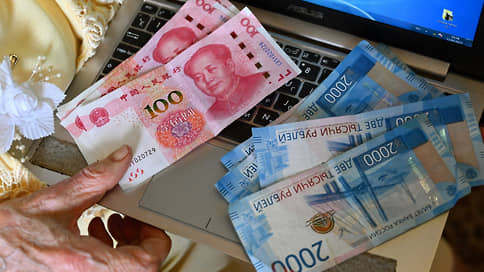Banks increase lending in yuan
[ad_1]

Russian banks began to actively increase the issuance of loans in yuan. This is happening, among other things, against the backdrop of rising ruble rates, with which participants in foreign economic activity are no longer comfortable working. However, lending in Chinese currency is constrained by insufficient funding for banks. Rising borrowing rates, including in China, threaten the margins of credit institutions.
As Natalya Voevodina, head of Rosbank, said at a meeting with reporters on November 13, among the trends in the third quarter, they note the growth of the corporate loan portfolio in yuan: it increased 1.5 times. In ten months, the bank’s press service clarified, the portfolio more than doubled, to CNY 7.2 billion.
Sberbank told Kommersant that since the beginning of the year, the loan portfolio in yuan has grown by more than an order of magnitude. In September, Deputy Chairman of the Board of Sberbank Anatoly Popov spoke in an interview with Interfax about CNY 90 billion. At Alfa Bank, since the beginning of the year, the loan portfolio in Chinese currency has increased by 46%, and by 20% in the third quarter. Currently, it amounts to CNY 26 billion, about 10% of the entire corporate portfolio, the bank noted. At Ingosstrakh Bank, a significant increase (70%) in loans in yuan occurred at the end of the third and beginning of the fourth quarter.
According to the Central Bank, since the end of last year there has been a general stable increase in the share of loans in “friendly” currencies in the corporate foreign exchange portfolio. By October 1, it was close to 30%, whereas a year ago it was less than 2%.
The recent revival of lending in yuan, says Deputy Chairman of the Board of Ingosstrakh Bank Andrei Lapko, is due to the fact that after the recent increase in the key rate for some Russian exporters, ruble loans “have become extremely expensive.” From mid-July to early November, the Bank of Russia in several steps doubled the key rate to 15%.
According to Mr. Lapko, now rates on ruble loans and loans in yuan can differ by up to three times. “Our ruble lending rate is approximately two times higher than the lending rate in yuan,” Alfa Bank clarified.
As Natalya Voevodina explained, from one-time foreign exchange contracts, which were a characteristic feature of 2022, clients are moving to “serial”, longer ones, which is why they need longer-term financing. According to Andrey Lapko, as a rule, this is working capital financing for Russian exporters with yuan revenue (loans for a period of 1 year).
Alfa Bank notes a great demand for lending in yuan, both “long-term” for the implementation of investment projects, and for short periods to replenish working capital. As for demand, it is supported by the upcoming high season in anticipation of the end of the year, notes Mr. Lapko.
At the same time, competition for foreign currency borrowers is increasing. Traditionally, it is concentrated in the interest rate and lending conditions (flexibility, covenants, ease of working with loan tranches, etc.), notes Andrey Lapko. In terms of interest rates on loans in yuan, “the market is now at 5.5% per annum,” he says. “This is the basic level. It correlates with investments in yuan bonds, which are now issued by a number of issuers (see Kommersant on October 13.— “Kommersant”). And therefore, in banks that have liabilities in yuan, there is always competition between investing in client loans and purchasing yuan bonds,” explains Mr. Lapko.
Meanwhile, the general shortage of yuan on the Russian market (see Kommersant on August 18) contributes to an increase in rates in this currency. “In fact, today the growth of lending in yuan is restrained not by a lack of demand, but by an insufficient amount of funding,” explains Alfa Bank.
In addition, lenders remain at risk of changes in rates in China. If the base interest rate in China begins to rise, notes Vladimir Evstifeev, head of the analytical department of Zenit Bank, previously issued loans in yuan for banks will turn out to be less attractive, since they will reduce the net interest margin.
[ad_2]
Source link





